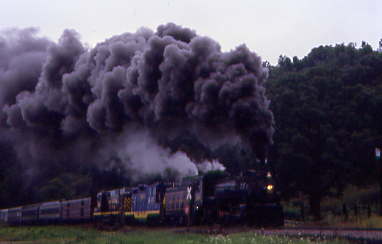
This was the final excursion of the 2006 National Railway Historical Society convention. Once again, we will be boarding the train at Dennison and heading west over the Ohio Central for today's unique triangle trip. As our train did on Thursday, we will run via the former Pennsylvania Railroad through the broad valley of the Tuscawaras River to Morgan Run. From Morgan Run, we will head north to Brewster to the Wheeling and Lake Erie Railroad. From Brewster, we will head east on the Wheeling and Lake Erie Railway to Bowerston where we will rejoin the Ohio Central and once again head west back to Dennison. On a railroad map, this route looks like a triangle.
When we arrive at Morgan Run shop (Milepost 118), we will make a short stop to pick up passengers who took the optional shop tour. The locomotives will be placed on the other end of the train and we will pull around the transfer switch at the shop and head north on the Ohio Central. This line was former Nickel Plate trackage, which was part of the W&LE before NKP acquired the carrier in the 1940's. It was later owned by Norfolk and Western and then Norfolk Southern before being purchased by the Ohio Central railroad in 1988. Leaving Tuscawaras Valley, we will be travelling over the locally-famous Baltic Hill, some five miles of curving 1.00 to 1.40 percent grade into the Amish community of Sugarcreek. Notice many farms with no electricity; these farms belong to Amish families who still live the same way they did 100 years ago. This trip is unique in the fact we will see many different scenery changes from flat fields in the Tuscawaras Valley to dense rolling hills of Amish Country and the hills of the Eastern Ohio coalfields.
About 17 miles north of Sugarcreeek near Warwick, we will turn west onto the W&LE and head into their Brewster Yard. Brewster is the corporate home of the Wheeling & Lake Erie Railway. The tree-storey dark red brick building we pass as the train enters the yard is the headquarters and dispatch centre. It housed the first Wheeling, then become local operating headquarters for the NKP and N&W before reverting, in 1990, back to its role under the present "Wheeling". Today's Wheeling and Lake Erie is a regional railroad with nearly 850 miles of track in Ohio, Pennsylvnaia, West Virginia and Maryland. Brewster remains as the principle maintenance facility on the system. At one time. this was the site of a major steam locomotive shop, first for the Wheeling and then the Nickel Plate.
From the yard, we will back around the north leg of the wye at Harmon before heading east towards Bowerston. This north leg of the wye goes to Canton and beyond. At Bowerston, we will interchange back with the Ohio Central Railroad. At this point, and for some 10 miles eastward, the two lines operate on combined trackage, owned by Ohio Central. WE will again change directions at this junction and travel west again back to Dennison.
The ExcursionThe train would leave Dennison on this rainy morning at 8:00 AM and arrive at Morgan Run by 9:15 AM. When Chris Parker and I arrived at the shops, Ohio Central 1293 was already steamed up and ready to go. Our excursion train from Dennison arrived with Ohio Central RS-11 1800, Orrville Railroad Historical Society GP7 471 and Ohio Central F40PH 271.
Ohio Central 1293 waited to reverse onto the front of our train and I boarded, very glad to be out of the rain and found that the car host in Pennsylvania Railroad coach RPCX 101 had saved some seats for us so I grabbed one for Chris and I. While I was doing that, 1800 and 471 cut off our train and went to the track on which Ohio Central 1293 was. Next, 271 pulled us down past the switch before Ohio Central 1293 and friends reversed onto our train. With us now facing the correct direction for Brewster, we departed.
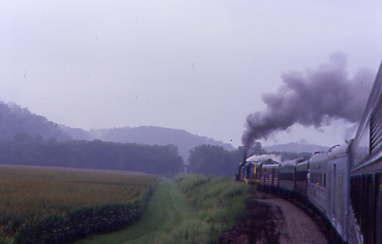
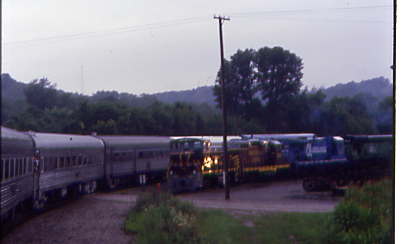
Ohio Central 1293 took us out of Morgan Run northeast and I said goodbye to Morgan Run on a very wet day so far. A photo runby was announced for a few minutes later, so everyone prepared and upon arrival at a farm crossing, we all detrained, many with umbrellas. The photo line would be the edge of Ohio Highway 93.
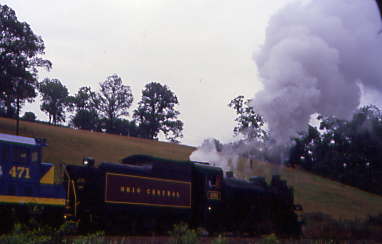
Ohio Central 1293 waited to start its reverse move and a call was made for all umbrellas to be put down and guess what, it stopped raining!
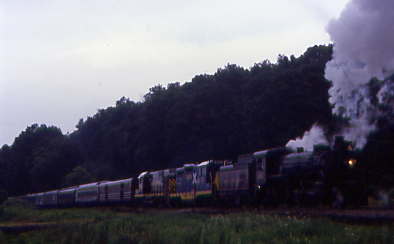
The reverse move.
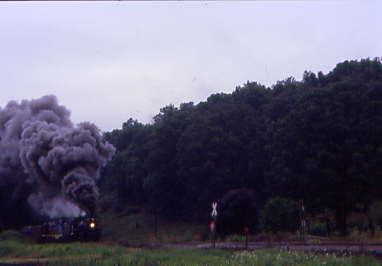

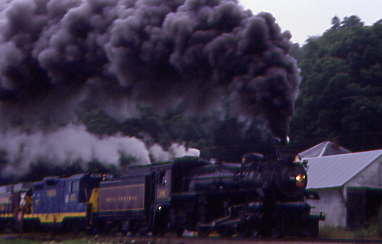
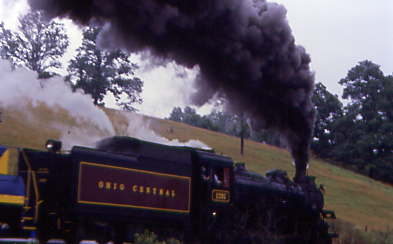
Photo runby one, which was excellent. Soon we were back onboard and continued north. It was announced that the next stop would be the Pearl Valley Cheese Factory where we would be for about an hour.
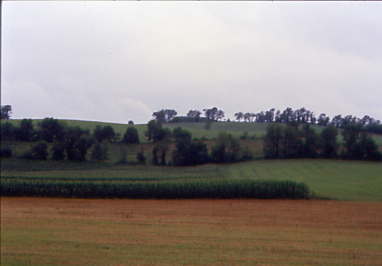
Traversing through the green Ohio countryside.
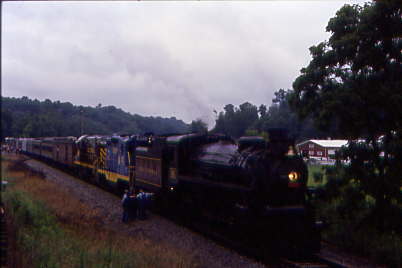
Upon our arrival at Pearl Valley, the train had to be split in two because of the factory entrance.
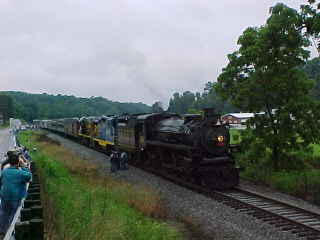
Our train at Pearl Valley.
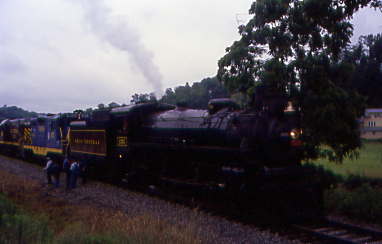
Ohio Central 1293 at rest.
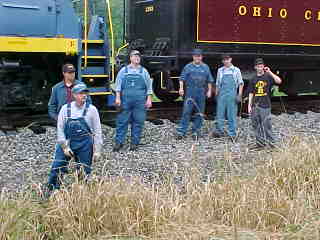
The Ohio Central steam crew.
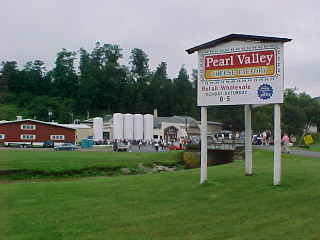
The Pearl Valley Cheese Factory. For over 95 years, Pearl Valley Cheese has grown into the company it is today, committed to manufacturing high-quality cheese, building lasting relationships and serving our customers. In 1928, Ernest Stalder, a Swiss immigrant to Ohio, purchased the Pearl Cheese Company. It consisted of a small building where a single 200-lb. wheel of cheese was made daily in a copper kettle. He also purchased the neighboring house for a total of $700. This was the humble beginning of Pearl Valley Cheese. The next year, Ernest married Gertrude Bandi, a Swiss immigrant, and from that point forward, she was highly involved in all business decisions. In 1932, the first truck delivered milk to the factory. Previously, the milk was brought in by horse and wagon. Then in 1938, the Stalders built a new factory just across the road from the previous location, which now had electricity and multiple copper kettles and presses.
In the 1940's, Pearl Valley began making brick cheese because most of the able-bodied men were away at war, and the 200-lb. wheels of Swiss cheese were difficult for the women to maneuver. This production eventually subsided as the Colby business grew. In 1947, The Ohio Farmer magazine wrote that Pearl Valley Cheese was the largest cheese plant in all of Ohio. This title is no longer accurate, but it's still an interesting fact! The Colby cheese operation was added to our facility in the 1950's and is still a vital part of our diversified business today. Colby cheese varieties make up about half of our production and give us a key distinction from other Ohio cheesemakers who focus solely on the Swiss. Also, during this time, Swiss cheese began to be manufactured in blocks instead of wheels. It was more efficient to make larger batches of cheese at a time in blocks, and they cut well into "sandwich cuts" that could be sold in grocery stores in the deli case.
In 1969, the final copper kettles were replaced with 2,000-gallon stainless steel, steam-lined vats. The 1970's saw additional construction at the factory included a space for the growing Colby business as well as additional warm room space for the Swiss. By 1982, Pearl Valley stopped purchasing milk in cans. Buying milk in bulk was less labour intensive and typically better quality. Then in 2001, Pearl Valley expanded again after purchasing the neighbouring farm. A 20,000-square-foot production facility was built, and double-O enclosed vats were installed, which allowed for increased production of Swiss and Colby varieties. This expansion increased our capacity to custom manufacture and private label as well as promote and sell our own brand.
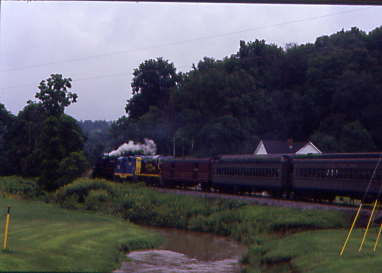
A different view of our train.
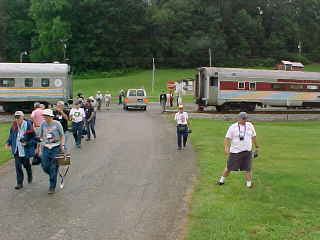
Chris Parker walking into the Cheese Factory.
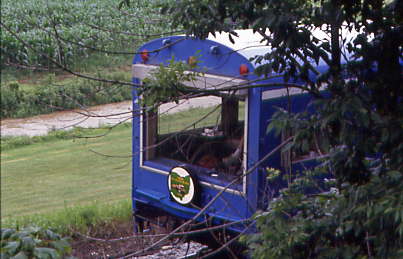
I had to walk out of Pearl Valley to photograph our train's drumhead with the NRHS 2006 Convention emblem.
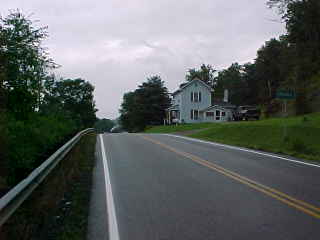
As I walked past the blue house on the way back to the train, there were barking dogs.
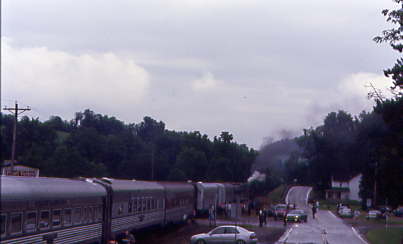
A view of the train and Pearl Valley. All the passengers who had detrained at Pearl Valley returned and at noon, Ohio Central 1293 and our train departed for Sugarcreek and I sat back and enjoyed the ride as the train climbed Baltic Hill.
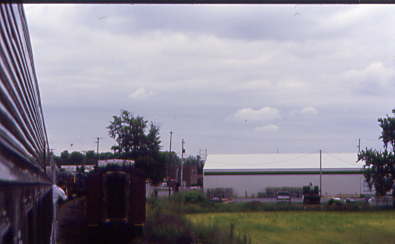
As we entered Sugarcreek, we first passed Ohio Central's passenger cars that were once used on excursion trains that originated here.
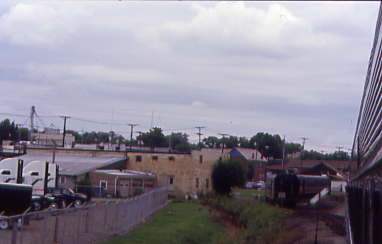
The other side of our train showed even more passenger cars.
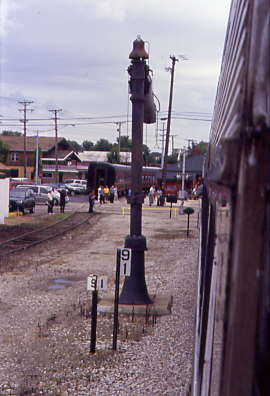
After Ohio Central 1293 cut off our train and reversed into a siding, we moved forward with 471 and 1800, passing the water plug that the steam engine used back in the excursion days.
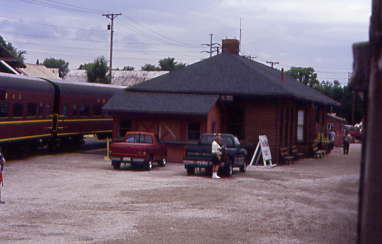
The Sugarcreek station had even more passenger cars behind.
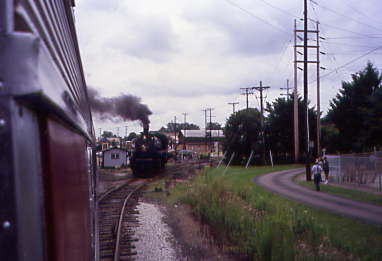
We said our goodbyes to Ohio Central 1293 and thanked it for the two great excursions this week. I would now sit back and relax on this last convention trip.
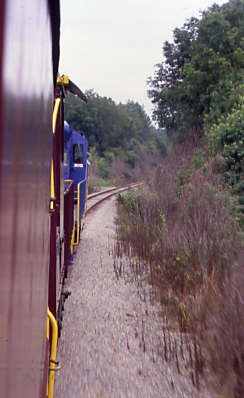
Continuing to climb after we departed Sugarcreek.
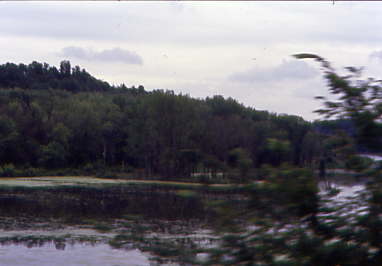
Passing several lakes on the way to Brewster. As we neared there, I used Chris Parker's cell phone to call Let's Talk Trains then I prepared for our arrival in Brewster. The rain started again but we were all happy it did had held off both times we had been outside.
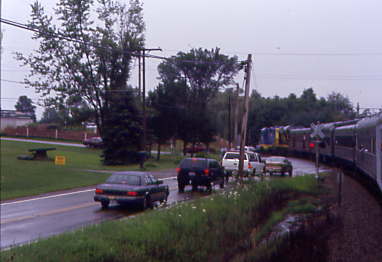
Rounding a tight curve as we crossed a local highway.
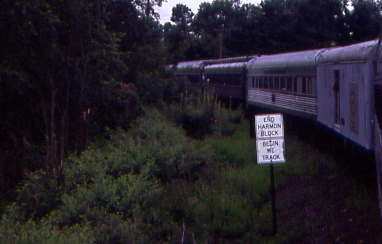
Entering the Wheeling & Lake Erie tracks that we would be on this afternoon until we reached Bowerston.
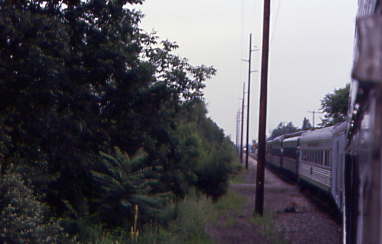
We then curved onto the W&LE mainline and proceeded west to the station.
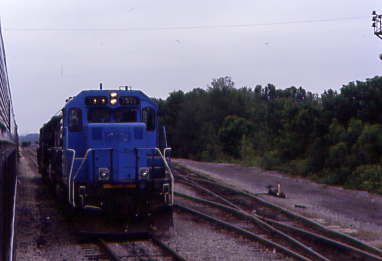
Wheeling and Lake Erie SD40-2 7377, ex. General American Transporation 7377, exx. Union Pacific 4198, nee Missouri Pacific 3198 built by Electro-Motive Division in 1975.
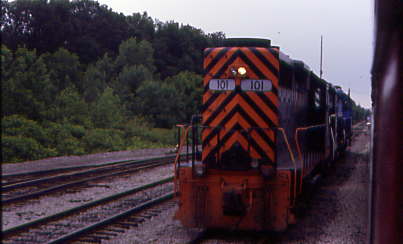
Wheeling and Lake Erie GP35 101, ex. Pittsburgh and West Virginia 101, nee Norfolk and Western 1301 built by Electro-Motive Division in 1964.
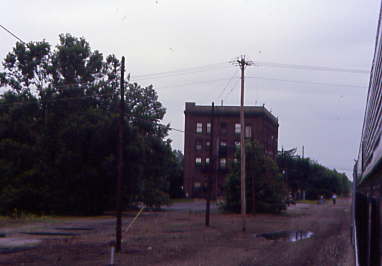
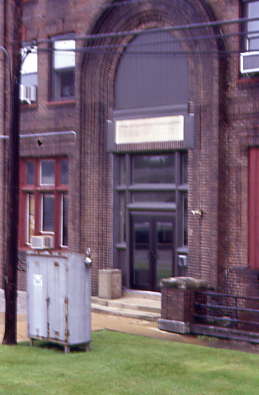
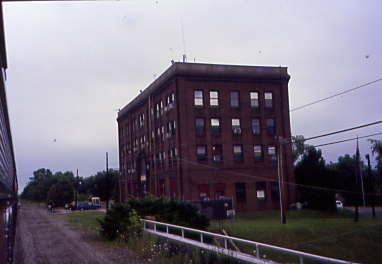
At the Wheeling & Lake Erie station, built in 1914 and commonly known as The Brick, or the largest skyscraper in Brewster, we picked up our W&LE crew for the trip to Bowerston and once they were aboard, we continued to pull forward.
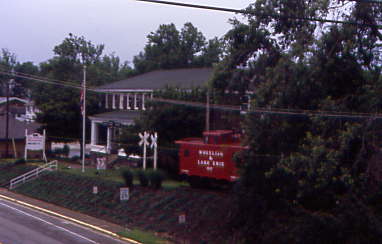
Wheeling and Lake Erie caboose 0217, built by the railroad in 1948. The building adjacent is the Wheeling and Lake Erie YMCA building which is now called the Wandle (Wheeling and Lake Erie) House, a museum and restaurant.
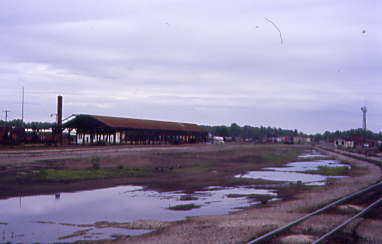
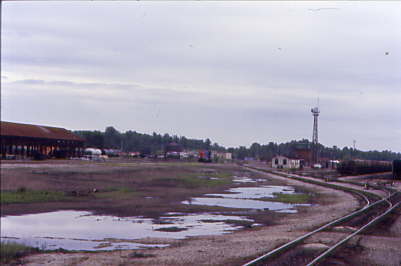
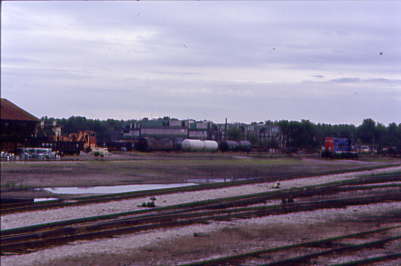
The Wheeling & Lake Erie yard and shops. The train then reversed down to the wye at Harmon, which is where the line to Cleveland takes off.
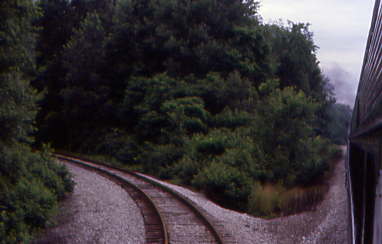
We reversed down the northwest leg of the wye and would take this leg to be pointed eastward.

The train, now facing forward east, took this leg of the wye to reach the W&LE mainline.
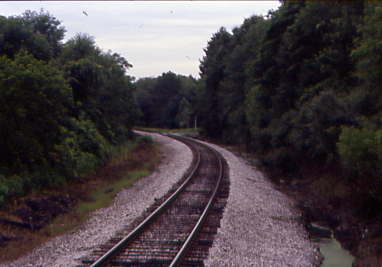
Our train has returned us to the W&LE mainline and took off at the fastest speed of the entire convention.
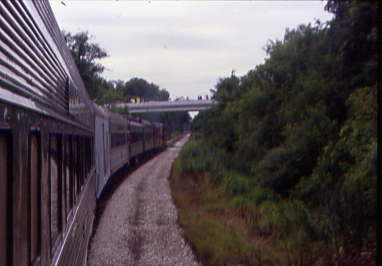
The railfans found us again on a bridge, most of whom we would not see again until Bowerston.
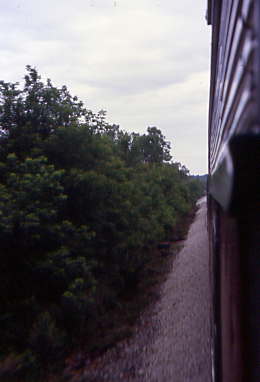
Rolling east at 40 mph down a very well-maintained railroad.
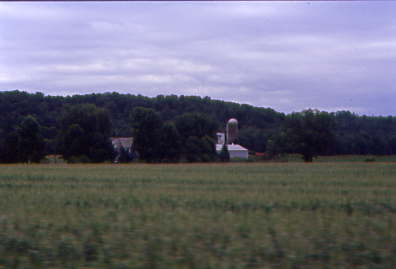
Passing another Ohio farm on the way to Bowerston.
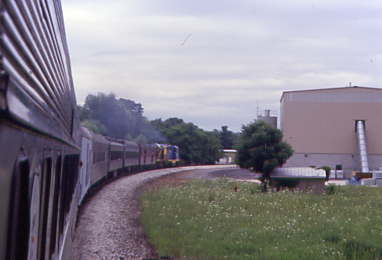
Rounding a curve at Zoar.
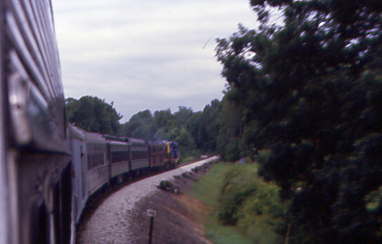
Another curve and we were at W&LE Milepost 44.
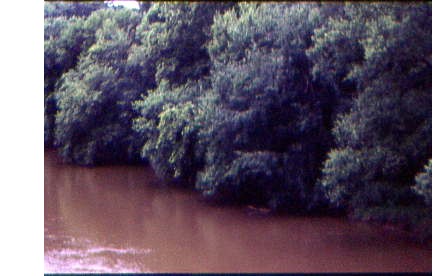
We crossed mostly muddy rivers from all the rain.
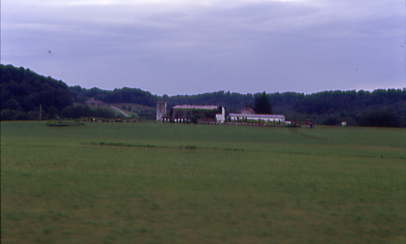
Pasing more farms and I loved all the green Ohio had to offer!
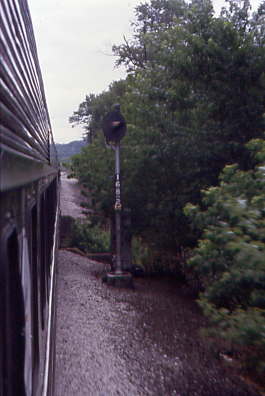
A signal told me we were approaching Bowerston.
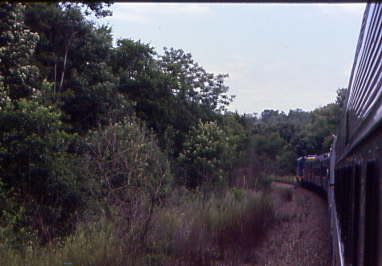
Arriving at Bowerston, where we stopped to change the position of our engines. First the engines cut off from the train, then 1800 cut off and went west onto the Ohio Central tracks. That was followed by 471 which reversed onto our train again and pulled us onto the Ohio Central mainline.
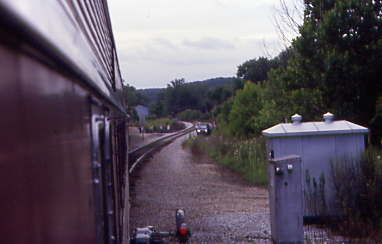
Ohio Central 1800 returned to our train and pulled it forward so we could detrain for a double photo runby, after which it reversed.
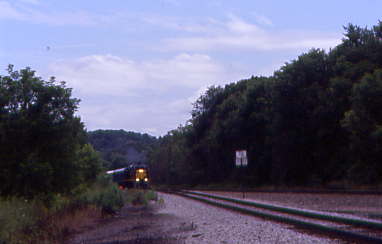
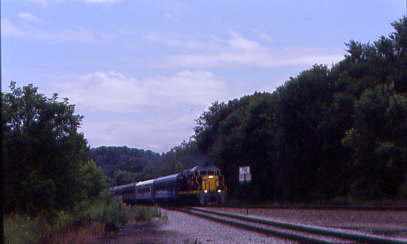
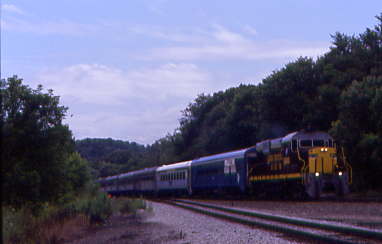
Photo runby two.
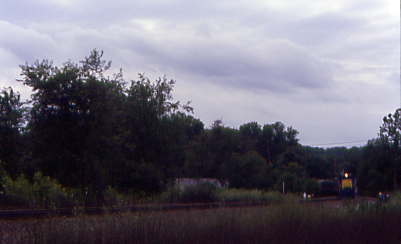
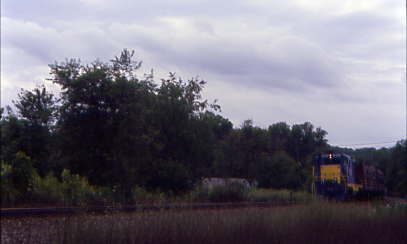
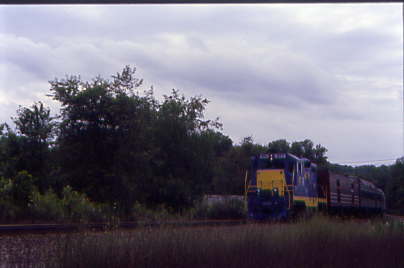
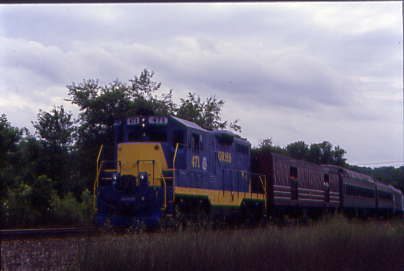
Photo runby three.
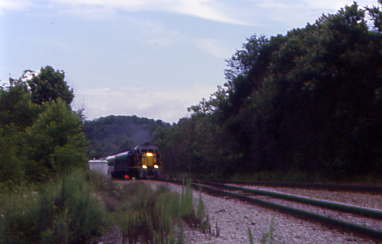
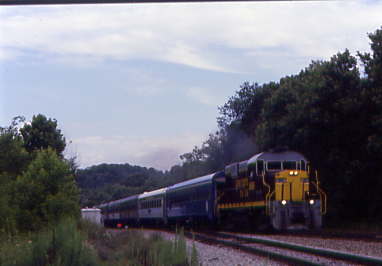
Photo runby four.
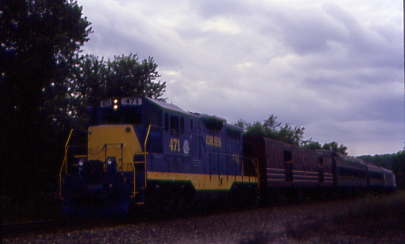
Photo runby five, the last of the convention. The conventioneers then reboarded for the final miles of this final convention excursion and we returned to Dennison. A special thank you to both the Ohio Central and Wheeling & Lake Erie Railroads. I was the first person off the train and in the front seat of the first bus to New Philadelphia. Chris Parker and I went to Hog Heaven for yet another excellent meal, before relaxing on our last night in New Philadelphia. Tomorrow we both go home, Chris on an airplane and me on Amtrak.
| RETURN TO THE MAIN PAGE |